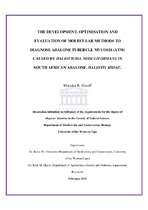| dc.contributor.advisor | Christison, Kevin W. | |
| dc.contributor.advisor | Macey, Brett M. | |
| dc.contributor.author | Greeff, Mariska R. | |
| dc.date.accessioned | 2015-03-24T08:39:16Z | |
| dc.date.available | 2015-03-24T08:39:16Z | |
| dc.date.issued | 2012 | |
| dc.identifier.uri | http://hdl.handle.net/11394/4033 | |
| dc.description | Magister Scientiae (Biodiversity and Conservation Biology) | en_US |
| dc.description.abstract | Land-based abalone aquaculture in South Africa started in the early 1990s and is
based on the local species Haliotis midae. This industry expanded with great success over the last decade. In 2006 abalone exhibiting typical clinical signs of tubercle mycosis was discovered for the first time in South African abalone culture facilities,posing a significant threat to the industry. Halioticida noduliformans, a fungus belonging to the Peronosporomycetes (formerly Oomycetes), has been identified as the causative agent of abalone tubercle mycosis (ATM). While diagnoses of this disease are currently done by gross observation and histopathology, these methods fail to be sensitive enough to identify the causative agent accurately and reliably.Molecular confirmation could provide for quicker more accurate diagnostic information. The aim of this study was to develop a DNA based molecular diagnostic test. Polymerase chain reaction (PCR) has been used to rapidly detect, characterise and identify a variety of organisms. Nucleotide sequences of the smalland large-subunit ribosomal ribonucleic acid (rRNA) and mitochondrial cytochrome oxidase subunit II (cox2) genes of H. noduliformans were compared with closely related Peronosporomycete gene sequences to identify potential PCR primer sites. H. noduliformans specific real-time quantitative PCR (Q-PCR) primer sets were designed and optimised for each of the selected genes. Results indicate that, although all tested primers sets could amplify fungal DNA, only the LSU and cox2 primer sets - v -demonstrated no cross-amplification with the closely related Peronosporomycete and non-fungal DNA tested in the present study. The H. noduliformans specific LSU primer set was chosen for further analysis and used for all subsequent real-time PCR assays. The lowest detection limit for the LSU primer set was evaluated by running Q-PCR on serial dilutions of known quantities of extracted H. noduliformans DNA.Serial dilutions were made in PCR grade water as well as in an abalone tissue matrix.The sensitivity of the Q-PCR reaction was determined to be 266 pg of H.noduliformans DNA per 25 μL reaction volume. However, inclusion of a nested PCR step, utilising universal fungal outer primers, followed by Q-PCR with the H.noduliformans LSU specific primers improved sensitivity to 0.266 pg of H.noduliformans DNA per 25 μL reaction volume. This equates to approximately 2.4spores per 25 μL reaction volume. DNA extraction protocols were optimised to ensure efficient and repeatable extraction of high quality fungal DNA from pure fungus and tissue samples spiked with known quantities of fungal DNA. PCR amplification efficiency and potential inhibition were examined for each extraction method. Results suggest that real-time PCR has great potential in monitoring and quantifying H. noduliformans on abalone culture facilities in South Africa. | en_US |
| dc.language.iso | en | en_US |
| dc.publisher | University of the Western Cape | en_US |
| dc.subject | Abalone | en_US |
| dc.subject | Disease | en_US |
| dc.subject | Tubercle mycosis | en_US |
| dc.subject | Peronosporomycete | en_US |
| dc.subject | Halioticida noduliformans | en_US |
| dc.subject | DNA extraction | en_US |
| dc.subject | Quantitative real-time polymerase chain reaction | en_US |
| dc.subject | Nested polymerase chain reaction | en_US |
| dc.title | The development, optimisation and evaluation of molecular methods to diagnose abalone tubercle mycosis (ATM) caused by Halioticida Noduliformans in South African abalone, Haliotis Midae | en_US |
| dc.type | Thesis | en_US |
| dc.rights.holder | University of the Western Cape | en_US |

